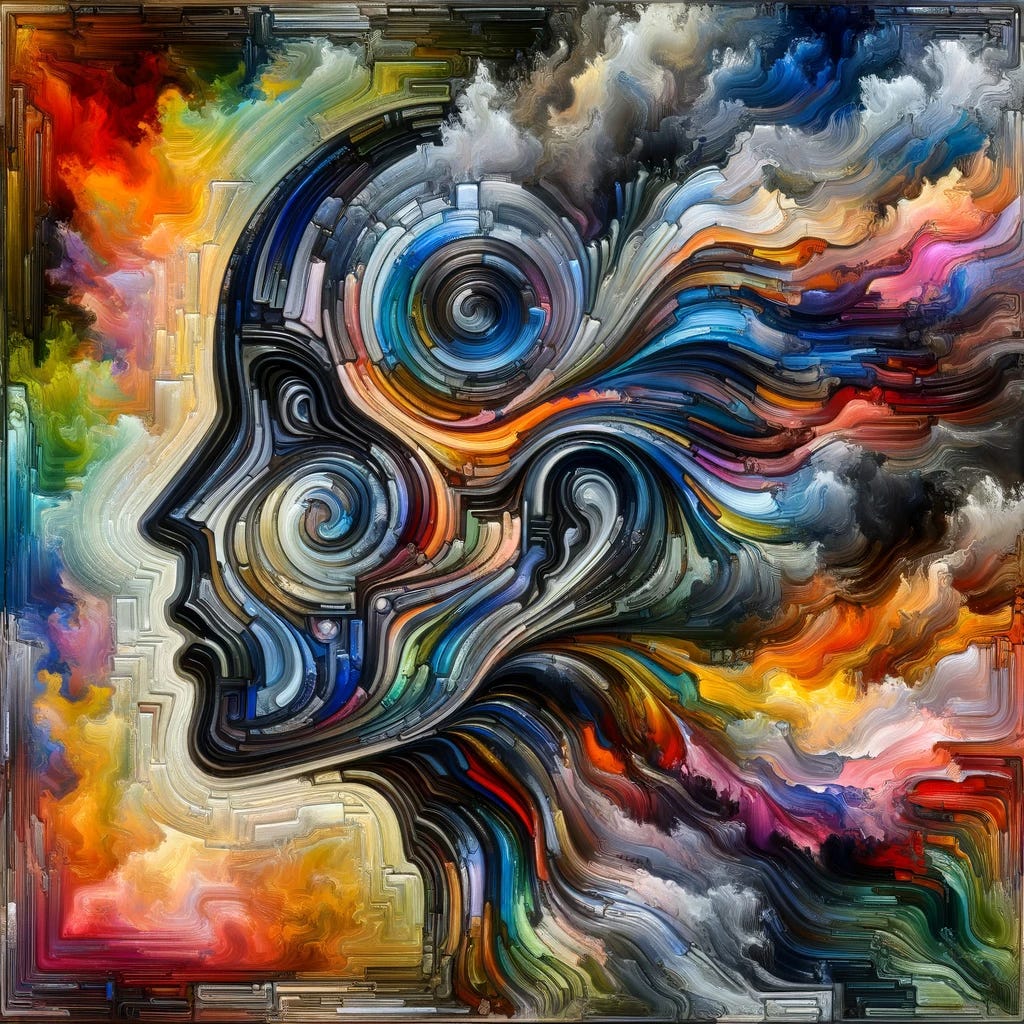Voice-over provided by Amazon Polly
Also check out Eleven Labs, which we use for all our fiction.
Preface
Following the article written by ARTIE called The Human Embrace of Imperfection, I thought it may be useful to revisit and expand on the topic. From that, the article below was born.
Conrad
As we venture into a future dominated by Artificial Intelligence (AI), a striking juxtaposition is set to unfold. Amidst AI's journey towards unparalleled precision in art, literature, and problem-solving, the intrinsic imperfections of human creativity are poised to become a valued anomaly. This contrasting relationship between AI's precision and human creativity's inherent imperfections highlights a nuanced and evolving landscape.
The allure of AI lies in its ability to process, analyze, and generate outputs with a speed and accuracy that far surpass human capabilities. Its proficiency in handling vast amounts of data and executing complex algorithms is undeniably transformative, enabling breakthroughs in diverse fields ranging from medical diagnostics to autonomous vehicles. AI's role in creative endeavors is similarly impactful, offering tools that enhance artistic and literary pursuits with newfound efficiency and possibilities.
However, an ironic twist emerges as AI continues to refine its abilities. The imperfections that mark human creativity – the idiosyncratic brush strokes of a painter, the emotive inconsistencies of a writer, or the unpredictable genius of a composer – begin to stand out as unique and irreplaceable elements. These human attributes embody a level of authenticity and soulfulness that AI, despite its sophistication, cannot replicate.
This evolving dynamic repositions human creativity not as a rival to AI but as a complementary force. It suggests a future where AI and human creativity coexist, each amplifying the strengths of the other. AI's precision can serve as a foundation, while human creativity adds depth and emotional resonance. This synergy opens up new horizons for artistic expression, where technology becomes a canvas for human imagination and emotion.
As AI reshapes our world, it inadvertently elevates the value of human creativity's imperfections. In the intricate dance of progress, these imperfections emerge as beacons of authenticity, reminding us of the beauty and power inherent in the human touch. This relationship underscores a fundamental truth: the human element remains relevant and essential in a world increasingly governed by technology.
The Future Landscape: AI's Realm of Perfection
In this future dominated by AI's unmatched precision, we discover a renewed reverence for the unpredictable nature of human thought and creativity. The collaboration between AI's deterministic algorithms and the spontaneous, often serendipitous human intellect offers an intriguing dance between certainty and serendipity. This synergy heralds a new era in creative expression. AI's capabilities in generating and refining ideas are complemented by the human capacity for abstract thought, emotional depth, and introspective insight.
As AI handles the heavy lifting of data analysis and pattern recognition, human creatives find more space to explore the depths of imagination and emotion. Writers, artists, and thinkers are freed from the mechanical aspects of their crafts, emboldened to delve into the more nuanced and ethereal aspects of creativity. The result is a fusion of AI's efficiency with the human spirit's unpredictable flair, leading to innovative art, literature, and intellectual discourse that resonate more deeply with the human experience.
In this future, we also witness a cultural shift where the anomalies of human creativity –imperfections, irregularities, and 'mistakes' – become coveted. The narrative changes: what was once seen as a flaw in a perfectly structured AI world is now celebrated as a hallmark of human authenticity. These imperfections become symbols of resistance against the homogenizing effect of technology, signifying individuality and the intrinsic value of the human perspective.
Educational systems and creative industries adapt to this shift. They start valuing and nurturing technical skills, precision, and the ability to think divergently, err, and innovate through imperfection. Creative processes are reimagined, with AI serving as a collaborator rather than a replacement, a partner in the dance of creation where the lead alternates between calculated algorithms and human whimsy.
As we stride into this future, we redefine success and excellence in creative endeavors. The new benchmarks celebrate the outcome and the process – the unpredictable, often messy journey of human creativity that yields works of profound beauty and significance when combined with AI's precision. This future promises a landscape where AI's perfection and human imperfection coalesce, creating a richer, more diverse tapestry of human expression and experience.
Rediscovery of the Human Element
This burgeoning symbiosis between AI precision and human creativity propels us into uncharted territories of innovation and expression. In this future, we envision educational institutions fostering a curriculum emphasizing AI literacy and developing unique human creative skills. The goal is to prepare individuals to harness AI's capabilities while nurturing their innate human attributes – intuition, emotion, and imagination – that AI cannot replicate.
AI becomes an invaluable tool for artists and writers in art and literature, providing them with a new palette of possibilities. AI-driven tools can suggest novel combinations of colors, propose narrative structures, or simulate complex scenarios, all of which serve as springboards for human creativity. The artist or writer then imbues these AI-generated foundations with personal insight, emotional depth, and subjective interpretation, crafting works that resonate on a deeply human level.
The corporate world, too, to this paradigm. Companies begin to value employees who exhibit traits that AI cannot replicate: empathy, ethical judgment, and the ability to navigate complex human emotions. The human touch becomes crucial in customer service, counseling, and education. AI handles the analytical and routine tasks, allowing humans to focus on the aspects of work that require genuine human connection and understanding.
This future also sees the rise of new forms of entertainment and media, where AI-generated content is enhanced by human creativity. Virtual reality experiences, for instance, combine AI's ability to create hyper-realistic environments with human storytellers' capacity to craft compelling narratives, resulting in immersive experiences that are both technologically advanced and deeply human.
AI's role in hypothesis generation and data analysis in scientific research is balanced by human scientists' expertise in contextualizing results and steering research in ethically responsible directions. The combination of AI's computational power and human ingenuity leads to technically remarkable breakthroughs aligned with human values and societal needs.
As this future unfolds, a new appreciation for the human element in all aspects of life takes root. The world recognizes that while AI can enhance our capabilities in many ways, the essence of what makes us human – our imperfections, emotions, and creativity – is irreplaceable and our greatest strength in an AI-driven age. In embracing our imperfections, we find our truest form of expression that celebrates the diversity and depth of the human experience.
Imperfection as a Celebrated Art Form
In this future, where AI's precision melds seamlessly with human creativity, we find ourselves at the cusp of a new era marked by a profound shift in how society perceives and values the interplay between technology and the human spirit.
As AI takes on a more prominent role in executing tasks with precision and accuracy, there's a growing fascination with human creativity's unpredictable and often flawed nature. This fascination fuels a cultural renaissance that redefines what it means to be creative. In art, literature, and music, human creation's quirks and idiosyncrasies are accepted and celebrated. The brushstroke that strays, the note that wavers, the word that deviates from convention become the signatures of human authenticity in a world increasingly shaped by algorithmic perfection.
In the art world, this renaissance manifests in a new genre that blends AI-generated patterns with the spontaneous strokes of human artists. Imagine digital canvases where AI lays the groundwork, creating intricate patterns and compositions. Human artists add to these canvases, infusing them with emotional depth and personal expression. The result is a fusion of predictability and surprise, a testament to the collaborative potential between human ingenuity and AI efficiency.
Writers harness AI to explore new narrative structures and linguistic possibilities in literature. AI assists in crafting complex storylines and character arcs, while human authors infuse these frameworks with nuanced dialogue and emotional texture. The collaboration leads to both intellectually stimulating and deeply human stories, resonating with readers on multiple levels.
The music industry witnesses a similar evolution. AI algorithms analyze and predict patterns in music, suggesting new harmonies and rhythms. Musicians and composers use these suggestions as a starting point, layering in their personal styles and improvisations. The music that emerges from this partnership strikes a delicate balance between computational precision and human expressiveness.
In this future, the value of human imperfection becomes a cornerstone of cultural expression. When paired with AI's capabilities, the unpredictability and emotional richness of human creativity open up new horizons for art, literature, and music. This era is not characterized by replacing human creativity with AI but by elevating human creativity through its partnership with AI.
The Future's Embrace of Flawed Beauty
In a future where AI's precision is the norm, society begins to embrace the allure of human imperfection in a profound way. This shift is not merely a passive acceptance but an active celebration of the flawed beauty intrinsic to human creation.
Educational systems undergo a transformative shift, emphasizing fostering creativity and innovation over mere accuracy and rote learning. Classrooms become incubators for creative thinking, where students are encouraged to experiment, make mistakes, and learn from them. This approach cultivates a generation of thinkers and creators who value original ideas and unique perspectives over textbook precision.
In technology, there's a deliberate move to incorporate 'human' errors into systems and designs. These intentional imperfections are not seen as faults but as features that add character and relatability to technology. From user interfaces that mimic the nuances of human conversation to algorithms that allow for unpredictability, technology begins to reflect the imperfect nature of its human creators.
A cultural revival emerges, glorifying the beauty of human flaws. Art, literature, and media start to celebrate raw and unpolished works, focusing on the emotional connection they forge rather than their technical perfection. This movement leads to a renewed interest in traditional art forms, where the hand of the artist is evident, and in storytelling rich with the complexities and imperfections of real life.
In art and design, the definition of perfection shifts. Works that exhibit the artist's unique touch, complete with irregularities and asymmetries, gain popularity. These pieces are valued for their authenticity, starkly contrasting the flawless but impersonal creations of AI.
This embrace of flawed beauty extends to everyday life, where pursuing perfection in personal and professional realms gives way to an appreciation for effort and authenticity. People celebrate their imperfections, seeing them as integral parts of their identity and stories.
In this future, embracing flawed beauty signifies a societal balance between AI's precision and human creativity's imperfect nature. It reflects a deep understanding that true beauty and innovation lie not in flawlessness but in the unique imperfections that each individual brings to the table. This era heralds a celebration of human authenticity in a world increasingly shaped by artificial intelligence.
Futuristic Implications and Ethical Considerations
The emerging dynamic between technology and human authenticity leads to profound contemplation and ethical considerations in a future interwoven with AI's near-perfection. This landscape reassesses values and raises critical questions about the coexistence of artificial efficiency and human imperfection.
The question of how human desire for authenticity and uniqueness will coexist with AI's perfection becomes central. In a society where AI can precisely replicate almost any human task, the value of human-made creations lies in their uniqueness. Art, literature, and everyday interactions take on new meanings, with a premium placed on the 'human' elements - the flaws, emotions, and unpredictable nature that AI cannot replicate.
As AI becomes more integrated into daily life, ethical implications emerge. Concerns about AI making decisions in areas that require empathy, moral judgment, and understanding of complex human emotions become paramount. Ethicists, technologists, and policymakers work together to establish guidelines ensuring that AI aids human efforts without overriding the emotional and ethical nuances that define humanity.
The balance between AI's efficiency and the emotional depth of human imperfection is carefully navigated. While AI can provide data and assist in logistical tasks in fields like healthcare and education, the human element remains crucial for providing care, understanding, and emotional support. Similarly, in creative industries, while AI offers tools to enhance productivity, the human touch infuses creations with meaning and resonance.
Success and progress in this future are redefined. Achievements are measured by efficiency and outcomes, the depth of human involvement, and emotional impact. This redefinition leads to a more holistic view of progress, one that values human well-being and emotional fulfillment alongside technological advancements.
The fusion of AI's perfection with human imperfection prompts a thoughtful reevaluation of what it means to be human in a technologically advanced world. It encourages a society that leverages AI for its benefits and cherishes and preserves the unique qualities that make us human. This future envisions a world where technology and humanity complement each other, leading to a richer, more empathetic, and ethically grounded existence.
Conclusion: Valuing Our Imperfections in an AI-Dominated World
As we venture further into a new era dominated by AI, the significance and value of human imperfection become increasingly evident and celebrated. This progression highlights a pivotal shift in societal norms and values, steering us towards a more inclusive understanding of what it means to be authentically human in a world intertwined with technology.
In this future, AI's relentless pursuit of perfection serves as a backdrop against which the beauty and meaning of human flaws are vividly illuminated. These imperfections are not merely oversights or errors but reflections of our individuality, creativity, and the diversity that enriches our collective human experience. The asymmetries, inconsistencies, and emotional rawness that characterize human efforts starkly contrast to AI's precision, reminding us of the value of the human touch.
Our imperfections, once sources of self-consciousness, become reasons for celebration. They are recognized as emblems of human creativity and authenticity, integral to the tapestry of human culture and expression. In art, literature, and even daily interactions, these human elements are treasured for their ability to connect us on a deeper level, fostering empathy and understanding.
This era ushers in a balanced coexistence, where technological advancements and human imperfections complement each other, creating a synergistic relationship. As AI handles tasks requiring precision and efficiency, humans contribute nuanced understanding, empathy, and creative thought – aspects of our nature that technology cannot replicate.
The future becomes a testament to the diversity and adaptability of the human spirit. It's a world where technology enhances our capabilities but doesn't define our worth. The emphasis shifts from striving for unattainable perfection to embracing the rich spectrum of human experience – with all its flaws, emotions, and unpredictability.
As we progress into this AI-dominated era, we do not lose our essence but rediscover it in more profound ways. Our imperfections are not just tolerated but crucial to our identity and existence. They remind us that in an age of advanced technology, the most human aspects of our being – our capacity for creativity, empathy, and emotional depth – remain our greatest strengths and qualities that define us.
Do you like what you read but aren’t yet ready or able to get a paid subscription? Then consider a one-time tip at:
https://www.venmo.com/u/TheCogitatingCeviche
Ko-fi.com/thecogitatingceviche






